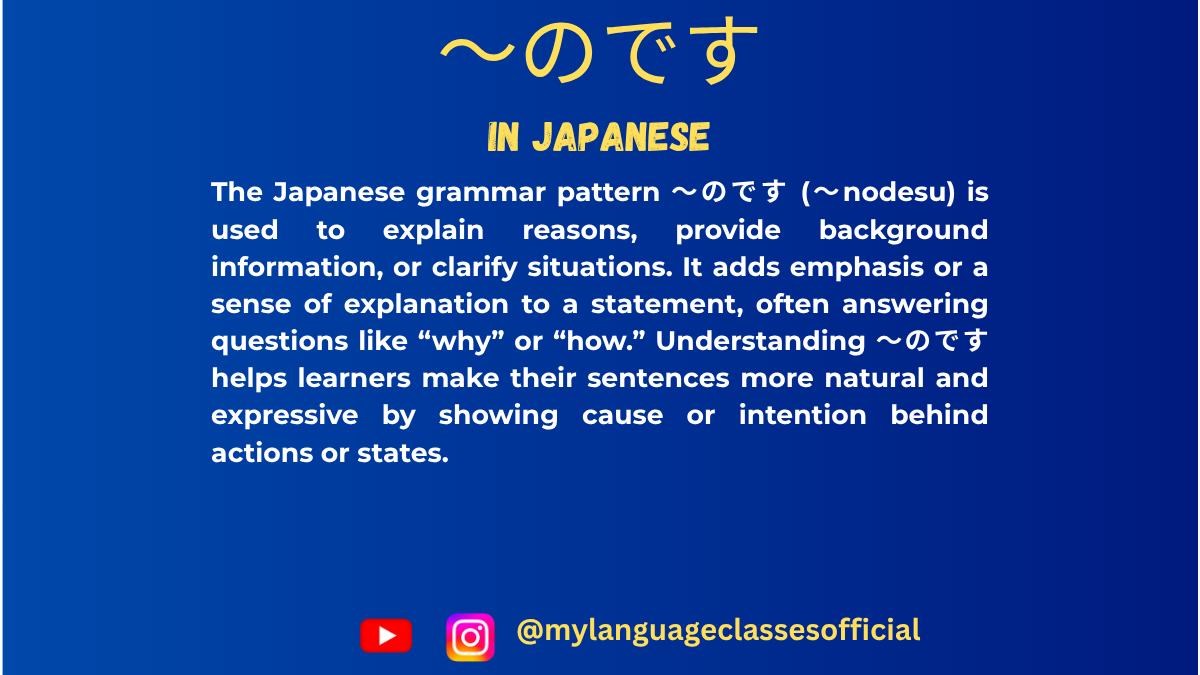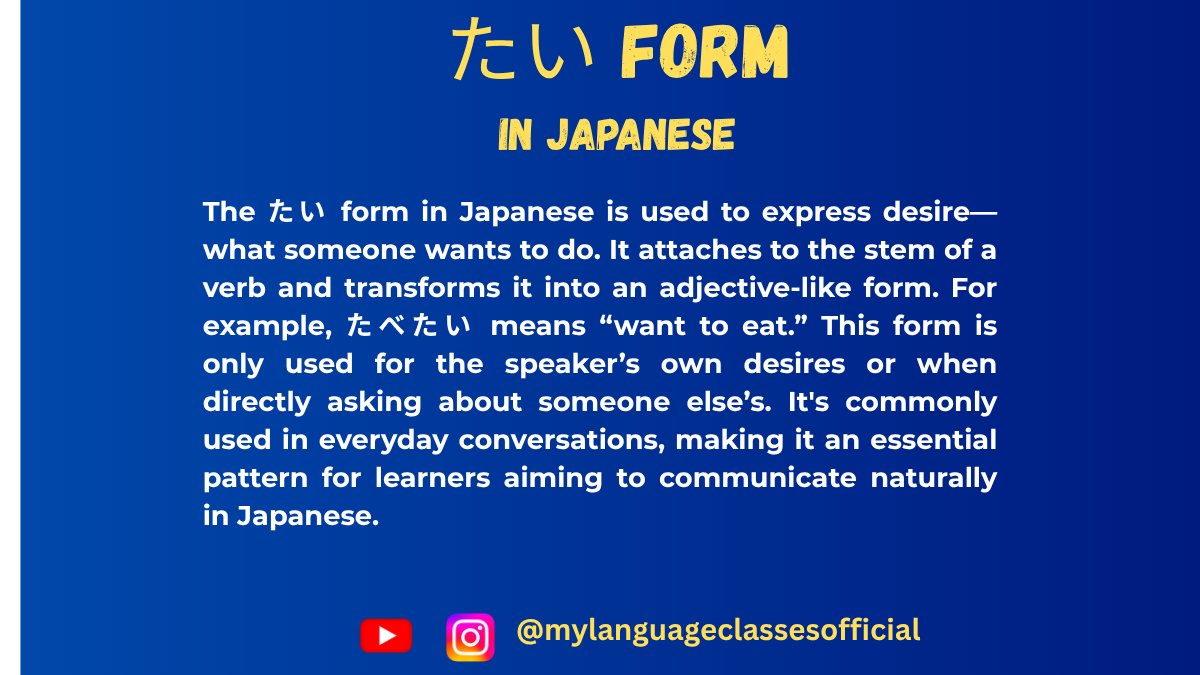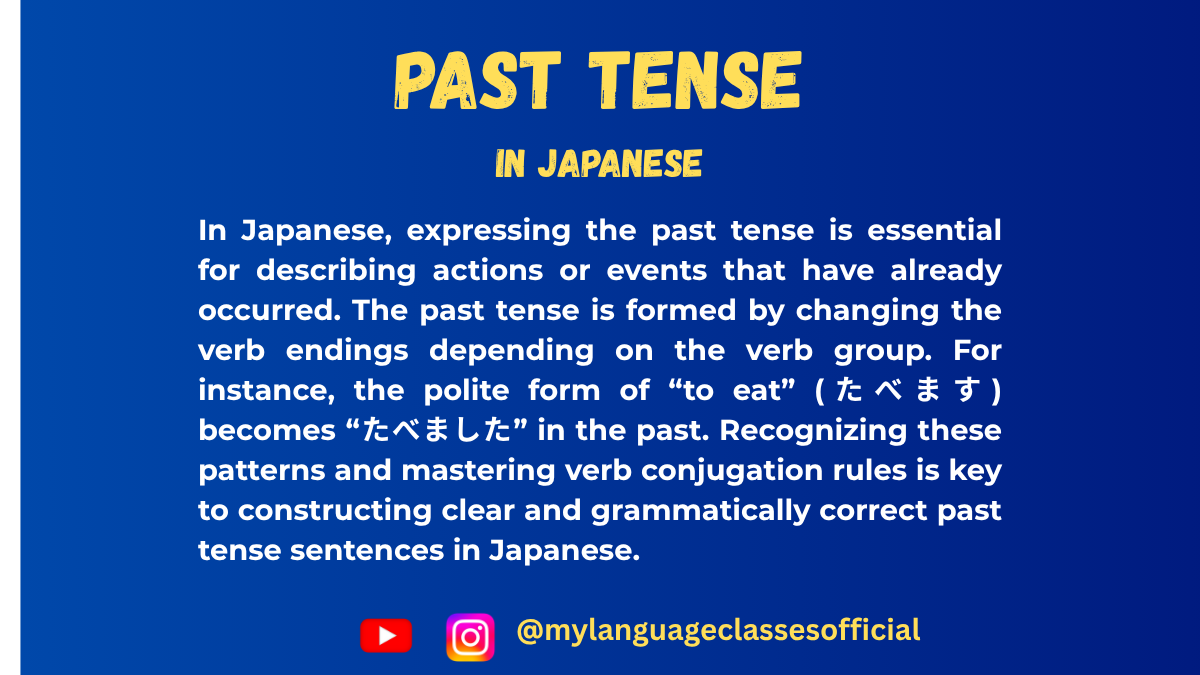Your cart is currently empty!
Tag: Verb Conjugation
-

Understanding 〜のですin Japanese | My Language Classes
Understanding 〜のです in Japanese
The 〜のです (or its casual form 〜んです) is a grammatical structure in Japanese used to give explanations, seek clarifications, or express emotions. It adds a sense of reasoning to a statement and is often used in both spoken and written Japanese.
Formation of 〜のです
1. Formation with Verbs
- Affirmative (Present/Future):
- Dictionary form + のです / んです
- Example: 食べるのです (taberu no desu)
- Negative (Present/Future):
- ない-form + のです / んです
- Example: 食べないのです (tabenai no desu)
- Past Affirmative:
- た-form + のです / んです
- Example: 食べたのです (tabeta no desu)
- Past Negative:
- なかった-form + のです / んです
- Example: 食べなかったのです (tabenakatta no desu)
2. Formation with Nouns
- Affirmative:
- Noun + なのです / なんです (casual)
- Example: 学生なのです (gakusei nano desu)
- Negative:
- Noun + ではないのです / じゃないんです (casual)
- Example: 学生ではないのです (gakusei dewa nai no desu)
3. Formation with Adjectives
- i-Adjectives:
- そのまま + のです / んです
- Example: うれしいのです (ureshii no desu)
- Negative: うれしくないのです (ureshikunai no desu)
- na-Adjectives:
- な + のです / んです
- Example: 静かなのです (shizuka nano desu)
- Negative: 静かではないのです (shizuka dewa nai no desu)
Usage of 〜のです
The 〜のです form is used in various situations. Below are the key contexts in which it is used:
1. Providing an Explanation
This form is often used to explain reasons behind actions or situations.
- Example: どうして遅れたのですか? (Why were you late?)
- Example: 雨が降っていたのです。(It was raining.)
2. Seeking Clarification or Confirmation
When you are trying to confirm or seek clarification about something.
- Example: その本はあなたのものなのですか? (Is that book yours?)
3. Expressing a Justification
To justify an action or event.
- Example: 宿題が多かったのです。(I had a lot of homework.)
4. Making a Statement More Emphatic
Using のです makes the statement more formal or assertive.
- Example: 私が行くのです。(I will go.)
5. Stating a Fact with Emphasis
- Example: これはとても大切なのです。(This is very important.)
Other Usage of 〜のです
Situations where 〜のです is used
- Giving explanations or reasons
- Asking for explanations or clarifications
- Expressing emotions such as surprise or concern
- Emphasizing a statement
- Giving background information
- Making an indirect request
- Softening a statement
- Seeking confirmation
- Expressing curiosity
- Describing an unusual situation
List of Verbs with their 〜のです Form
Verb (Dictionary Form) 〜のです Form Example Sentence 1 Romaji Meaning Example Sentence 2 Romaji Meaning 食べる (taberu) 食べるのです これは毎日食べるのです。 Kore wa mainichi taberu no desu. I eat this every day. 彼は魚を食べるのですか? Kare wa sakana o taberu no desu ka? Does he eat fish? 行く (iku) 行くのです 学校へ行くのです。 Gakkou e iku no desu. I am going to school. どこへ行くのですか? Doko e iku no desu ka? Where are you going? 来る (kuru) 来るのです 明日、彼が来るのです。 Ashita, kare ga kuru no desu. He is coming tomorrow. どうして来るのですか? Doushite kuru no desu ka? Why is he coming? 見る (miru) 見るのです 彼はテレビを見るのです。 Kare wa terebi o miru no desu. He watches TV. 何を見ているのですか? Nani o mite iru no desu ka? What are you watching? 書く (kaku) 書くのです 彼女は日記を書くのです。 Kanojo wa nikki o kaku no desu. She writes a diary. 何を書いているのですか? Nani o kaite iru no desu ka? What are you writing? 話す (hanasu) 話すのです 先生は日本語を話すのです。 Sensei wa nihongo o hanasu no desu. The teacher speaks Japanese. 彼と何を話していたのですか? Kare to nani o hanashite ita no desu ka? What were you talking about with him? 買う (kau) 買うのです 私は新しい車を買うのです。 Watashi wa atarashii kuruma o kau no desu. I will buy a new car. 何を買ったのですか? Nani o katta no desu ka? What did you buy? 泳ぐ (oyogu) 泳ぐのです 彼は毎朝泳ぐのです。 Kare wa maiasa oyogu no desu. He swims every morning. どこで泳ぐのですか? Doko de oyogu no desu ka? Where do you swim? 勉強する (benkyou suru) 勉強するのです 私は毎日日本語を勉強するのです。 Watashi wa mainichi nihongo o benkyou suru no desu. I study Japanese every day. 何を勉強しているのですか? Nani o benkyou shite iru no desu ka? What are you studying? 働く (hataraku) 働くのです 彼は銀行で働くのです。 Kare wa ginkou de hataraku no desu. He works at a bank. どこで働いているのですか? Doko de hataraite iru no desu ka? Where do you work? 走る (hashiru) 走るのです 彼は毎朝公園で走るのです。 Kare wa maiasa kouen de hashiru no desu. He runs in the park every morning. どのくらい走るのですか? Dono kurai hashiru no desu ka? How far do you run? 歌う (utau) 歌うのです 彼女はとても上手に歌うのです。 Kanojo wa totemo jouzu ni utau no desu. She sings very well. どんな歌を歌うのですか? Donna uta o utau no desu ka? What kind of songs do you sing? 覚える (oboeru) 覚えるのです 私は新しい単語を覚えるのです。 Watashi wa atarashii tango o oboeru no desu. I memorize new words. どうやって覚えるのですか? Dou yatte oboeru no desu ka? How do you memorize them? 遊ぶ (asobu) 遊ぶのです 子供たちは公園で遊ぶのです。 Kodomotachi wa kouen de asobu no desu. The children play in the park. どこで遊ぶのですか? Doko de asobu no desu ka? Where do they play?
More Example Sentences
- 明日はテストがあるのです。
Ashita wa tesuto ga aru no desu.
(There is a test tomorrow.) - 彼女は病気なのです。
Kanojo wa byouki na no desu.
(She is sick.) - この本は大切なのです。
Kono hon wa taisetsu na no desu.
(This book is important.)
4. 彼は昨日学校を休んだのです。
Kare wa kinō gakkō o yasunda no desu.
(He was absent from school yesterday.)5. どうしてそんなに疲れているのですか?
Dōshite sonna ni tsukarete iru no desu ka?
(Why are you so tired?)6.この時計は祖父からもらったのです。
Kono tokei wa sofu kara moratta no desu.
(I received this watch from my grandfather.)7. 彼女は日本に行くのです。
Kanojo wa Nihon ni iku no desu.
(She is going to Japan.)8. 電車が遅れたのです。
Densha ga okureta no desu.
(The train was delayed.)9.その映画はとても感動的だったのです。
Sono eiga wa totemo kandō-teki datta no desu.
(That movie was very emotional.)10.雨が降っていたのです。
Ame ga futte ita no desu.
(It was raining.)
Things to Keep in Mind
- のです is often shortened to んです in spoken language.
- It is more polite and formal than a direct statement.
- Used in interrogative sentences to seek more information.
- Often used in written explanations and discussions.
Fill in the Blanks
- なぜ学校を休んだ____?
- 彼女は来ない____。
- 私は先生に質問した____。
- どうして泣いている____か?
- 彼は何も言わなかった____。
- あなたが怒っているのは知っている____。
- 昨日、帰りが遅くなった____。
- この本を読んだことがある____か?
- 今日は早く寝たほうがいい____よ。
- 彼がそんなことをするはずがない____。
Conclusion
The 〜のです form is an essential grammar structure that allows Japanese speakers to explain reasons, seek clarifications, and emphasize statements naturally. Mastering its usage will significantly improve your fluency in Japanese communication. Practice using のです in different situations, and you’ll soon find yourself speaking more like a native!
If you enjoyed this lesson, be sure to check out more posts like this on my blog at My Language Classes. Don’t forget to subscribe my YouTube channel and follow me on Instagram for the latest language learning tips and lessons. Leave a comment below to share your thoughts, or ask any questions you have about nouns.
Happy learning! 😊
- Affirmative (Present/Future):
-

How to Use たい Form in Japanese | My Language Classes
Mastering the Japanese たい Form: A Comprehensive Guide
When learning Japanese, expressing what you want to do is an exciting milestone. The たい form is a versatile and commonly used grammar pattern that helps convey your desires and preferences. Whether you’re talking about your favorite foods, activities, or hobbies, mastering the たい form will greatly enhance your conversational skills. Let’s break it down step by step!
What Is the たい Form?
The たい form is used to express the desire to perform a certain action. In English, this is equivalent to saying, “I want to [do something].” It attaches to the stem of a verb, making it both straightforward and easy to use.
Building the たい Form for All Verb Groups
In Japanese, verbs are categorized into three groups: Group 1 (う-verbs), Group 2 (る-verbs), and Group 3 (Irregular verbs). Let’s dive into how to form the たい form for each group.
Group 1 (う-Verbs)
Group 1 verbs, also known as う-verbs, have dictionary forms that end with an う sound (e.g., 飲む, 読む, 書く).
Steps to form the たい form:
- Remove the final う sound from the verb.
- Replace it with い and add たい.
Examples:
- 飲む (nomu, “to drink”) → 飲みたい (nomitai, “want to drink”)
- 読む (yomu, “to read”) → 読みたい (yomitai, “want to read”)
- 書く (kaku, “to write”) → 書きたい (kakitai, “want to write”)
Negative form:
- Follow the same steps to form the たい structure.
- Replace たい with たくない.
Examples:
- 飲む → 飲みたくない (nomitakunai, “don’t want to drink”)
- 読む → 読みたくない (yomitakunai, “don’t want to read”)
- 書く → 書きたくない (kakitakunai, “don’t want to write”)
Group 2 (る-Verbs)
Group 2 verbs, also known as る-verbs, have dictionary forms that end with る preceded by an い or え sound (e.g., 食べる, 見る).
Steps to form the たい form:
- Drop the る from the verb.
- Add たい to the stem.
Examples:
- 食べる (taberu, “to eat”) → 食べたい (tabetai, “want to eat”)
- 見る (miru, “to see/watch”) → 見たい (mitai, “want to see/watch”)
- 開ける (akeru, “to open”) → 開けたい (aketai, “want to open”)
Negative form:
- Drop the る from the verb.
- Add たくない to the stem.
Examples:
- 食べる → 食べたくない (tabetakunai, “don’t want to eat”)
- 見る → 見たくない (mitakunai, “don’t want to see/watch”)
- 開ける → 開けたくない (aketakunai, “don’t want to open”)
Group 3 (Irregular Verbs)
Group 3, or irregular verbs, includes only two main verbs: する (“to do”) and 来る (“to come”).
Steps to form the たい form:
- する: Replace する with したい.
- 来る: Change to 来たい (きたい, kitai).
Examples:
- する (suru, “to do”) → したい (shitai, “want to do”)
- 来る (kuru, “to come”) → 来たい (kitai, “want to come”)
Negative form:
- する: Replace したい with したくない.
- 来る: Replace 来たい with 来たくない.
Examples:
- する → したくない (shitakunai, “don’t want to do”)
- 来る → 来たくない (kitakunai, “don’t want to come”)
Summary Chart
Verb Type Dictionary Form Stem Positive たい Form Negative たくない Form Group 1 (う) 飲む (nomu) 飲み 飲みたい (nomitai) 飲みたくない (nomitakunai) Group 2 (る) 食べる (taberu) 食べ 食べたい (tabetai) 食べたくない (tabetakunai) Group 3 (Irregular) する (suru) — したい (shitai) したくない (shitakunai) 来る (kuru) — 来たい (kitai) 来たくない (kitakunai) Practice It!
Try converting the following verbs into their たい and たくない forms:
- 書く (kaku, “to write”)
- 遊ぶ (asobu, “to play”)
- 勉強する (benkyou suru, “to study”)
- 起きる (okiru, “to wake up”)
Let us know how you did in the comments!
Polite Forms
The examples above are in casual form, which is great for conversations with friends or family. To make it polite, simply conjugate the たい form with です:
- 食べたい → 食べたいです (tabetai desu, “want to eat”).
- 食べたくない → 食べたくないです (tabetakunai desu, “don’t want to eat”).
Examples:
- 映画を見たいです。
Eiga o mitai desu.
“I want to watch a movie.” - 海に行きたくないです。
Umi ni ikitakunai desu.
“I don’t want to go to the beach.”
Notes on Usage
- First-Person Focus:
The たい form is primarily used to express the speaker’s desires. For example:- 私はケーキを食べたいです。
Watashi wa keeki o tabetai desu.
“I want to eat cake.”
- 私はケーキを食べたいです。
- Context Matters:
Use たい sparingly in formal writing or professional settings. Instead, opt for more polite expressions such as ~たいと思っています (~tai to omotteimasu, “I am thinking I want to…”). - Flexibility in Sentences:
The たい form is flexible and integrates seamlessly into various sentence structures:- 何を食べたいですか?
Nani o tabetai desu ka?
“What do you want to eat?” - 明日は公園に行きたいです。
Ashita wa kouen ni ikitai desu.
“I want to go to the park tomorrow.”
- 何を食べたいですか?
Practice Makes Perfect
Try creating your own sentences with the たい form! Here are some practice prompts:
- What do you want to do this weekend?
- Name three things you don’t want to do.
- Use the たい form in a polite question.
Final Thoughts
The たい form is a valuable tool for expressing your wants and preferences in Japanese. Whether you’re planning your next meal or your next adventure, it helps bring personality and clarity to your conversations. Practice it often, and you’ll find yourself communicating your desires naturally in no time. 頑張って!(Ganbatte! – Good luck!)
What do you want to express in Japanese today? Share in the comments below! 😊
If you enjoyed this lesson, be sure to check out more posts like this on my blog at My Language Classes. Don’t forget to subscribe my YouTube channel and follow me on Instagram for the latest language learning tips and lessons. Leave a comment below to share your thoughts, or ask any questions you have about nouns.
Happy learning! 😊
-

Mastering the Past Tense in Japanese | My Language Classes
Mastering Japanese Past Tense
If you’re learning Japanese, understanding how to express actions in the past is essential for communication. Japanese verbs are logically structured, and once you master their conjugations, you’ll be ready to share stories, describe events, and more.
In this post, we’ll focus on the positive past tense and the negative past tense, with step-by-step explanations for verbs ending in different sounds (like -ku, -ru, -mu, and more). By the end, you’ll feel confident using these forms in your Japanese conversations.
The Basics of Japanese Past Tense
Japanese verbs don’t conjugate based on the subject, so there’s no distinction between “I ate” and “she ate.” The conjugation only reflects tense (past, present, etc.) and polarity (positive or negative).
The two forms we’ll focus on are:
- Positive Past Tense – For actions that happened.
- Negative Past Tense – For actions that didn’t happen.
1. Positive Past Tense: 食べた (tabeta) – “ate”
The positive past tense is based on the た-form of the verb. To create it, we modify the ending of the verb according to its type.
Group 1 (U-verbs)
For U-verbs, the conjugation depends on the final -u sound. Each sound (-ku, -ru, -mu, etc.) follows a specific rule:
Ending Change Example -う (u) Replace う with った 会う (au, “to meet”) → 会った (atta, “met”) -つ (tsu) Replace つ with った 待つ (matsu, “to wait”) → 待った (matta, “waited”) -る (ru) Replace る with った 走る (hashiru, “to run”) → 走った (hashitta, “ran”) -む (mu) Replace む with んだ 飲む (nomu, “to drink”) → 飲んだ (nonda, “drank”) -ぶ (bu) Replace ぶ with んだ 遊ぶ (asobu, “to play”) → 遊んだ (asonda, “played”) -ぬ (nu) Replace ぬ with んだ 死ぬ (shinu, “to die”) → 死んだ (shinda, “died”) -く (ku) Replace く with いた 書く (kaku, “to write”) → 書いた (kaita, “wrote”) -ぐ (gu) Replace ぐ with いだ 泳ぐ (oyogu, “to swim”) → 泳いだ (oyoida, “swam”) -す (su) Replace す with した 話す (hanasu, “to speak”) → 話した (hanashita, “spoke”) Examples:
- 待つ → 待った (matsu → matta): waited
- 書く → 書いた (kaku → kaita): wrote
- 泳ぐ → 泳いだ (oyogu → oyoida): swam
- 遊ぶ → 遊んだ (asobu → asonda): played
Group 2 (RU-verbs)
For RU-verbs, simply drop the る and add た.
Examples:
- 食べる (taberu, “to eat”) → 食べた (tabeta, “ate”)
- 見る (miru, “to see”) → 見た (mita, “saw”)
Irregular Verbs
There are two irregular verbs in Japanese with unique conjugations:
- する (suru, “to do”) → した (shita, “did”)
- 来る (kuru, “to come”) → 来た (kita, “came”)
2. Negative Past Tense: 食べなかった (tabenakatta) – “did not eat”
To express that something did not happen, we use the negative past tense, which builds off the ない-form of the verb.
How to Form the Negative Past Tense
- Convert the verb to its ない-form (present negative).
- Replace ない with なかった.
Group 1 (U-verbs)
The process for creating the ない-form depends on the ending of the verb:
- Change the final -u to its corresponding -a sound, then add ない.
Example: 飲む (nomu, “to drink”) → 飲まない (nomanai, “do not drink”). - Finally, replace ない with なかった for the past tense: 飲まなかった (nomanakatta, “did not drink”).
Examples:
- 書く (kaku, “to write”) → 書かない → 書かなかった (kakanakatta, “did not write”)
- 泳ぐ (oyogu, “to swim”) → 泳がない → 泳がなかった (oyoganakatta, “did not swim”)
- 話す (hanasu, “to speak”) → 話さない → 話さなかった (hanasanakatta, “did not speak”)
Group 2 (RU-verbs)
For RU-verbs, simply drop る and add ない, then conjugate to なかった.
Examples:
- 食べる → 食べない → 食べなかった (taberu → tabenai → tabenakatta): did not eat
- 見る → 見ない → 見なかった (miru → minai → minakatta): did not see
Irregular Verbs
The two irregular verbs follow special patterns:
- する → しない → しなかった (suru → shinai → shinakatta): did not do
- 来る → 来ない → 来なかった (kuru → konai → konakatta): did not come
Examples in Context
Positive Past Tense
- 昨日、本を読んだ。
(Kinō, hon o yonda.)
I read a book yesterday. - 友達に会った。
(Tomodachi ni atta.)
I met a friend.
Negative Past Tense
- 昨日、本を読まなかった。
(Kinō, hon o yomanakatta.)
I didn’t read a book yesterday. - 友達に会わなかった。
(Tomodachi ni awanakatta.)
I didn’t meet a friend.
Tips for Mastery
- Group Drill Practice: Practice conjugating verbs in groups based on their endings (-ku, -su, -mu, etc.) to build muscle memory.
- Daily Use: Write about your day using past tense. Did you eat? Watch a movie? Think about what you didn’t do as well.
- Flashcards: Use flashcards for common verbs in their dictionary, positive past, and negative past forms.
Understanding Japanese past tense empowers you to share your experiences and engage in deeper conversations. With regular practice, you’ll master these forms in no time. がんばって (Ganbatte, “Good luck!”)!
If you enjoyed this lesson, be sure to check out more posts like this on my blog at My Language Classes. Don’t forget to subscribe my YouTube channel and follow me on Instagram for the latest language learning tips and lessons. Leave a comment below to share your thoughts, or ask any questions you have about nouns.
Happy learning! 😊
